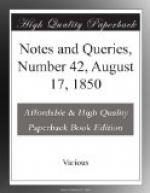HENRY WILKINSON.
Brompton.
North Sides of Churchyards unconsecrated (Vol. ii., p. 55.).—The strong preference given to the south side of the churchyard is traceable to two principal causes; first and chiefly, because the churchyard cross was always placed here; secondly, because this is the sunny side of the churchyard. The cross, the emblem of all the Christian’s hopes, the bright sun shining on the holy ground, figurative of the sun of righteousness, could not fail to bring to mind the comforting assurance that they who slept around would one day rise again. And as the greater part of the congregation entered the church by the south and principal door, another cause of the preference was the hope that the sight of the resting places of those of their friends and neighbours who had died in the communion of the church, might remind the survivors each time they repaired to the house of prayer to remember them in their supplications. {190} There is not, however, I believe, the slightest reason for considering that the north side of the churchyard was left unconsecrated, nor do I think it possible that such could ever be the case, inasmuch as all consecrated ground was required to be fenced off from that which was unhallowed. But the north side has always been considered inferior to the south. For example;—excommunicated persons were at one time buried outside the precincts of the churchyard, which, of course, would not have been necessary if any part had been left unconsecrated, nor are instances of this practice wanting since the Reformation.[1] And when discipline began to be relaxed, and murderers were interred even within the church itself, it was still on the north side.[2] It is very usual in small country parishes to find the north side of the churchyard without a single grave, nor is it generally resorted to until the south side is fully occupied. It would be difficult to mention another instance of a prejudice so universal, existing so long after the causes of it have mainly passed away.
I cannot conclude without expressing the extreme interest which, though he seems not to be aware of it, attaches to the statement of your correspondent, to the effect that he had on two occasions, namely, on the Revel Sunday, and on another festival, observed the game of football in a churchyard in the West of England. It is, indeed, interesting to find that relics of a custom which, however repugnant to our notions, was sanctioned by the highest authority in the best days of our church, still linger in some of our rural districts; thus amply bearing out the mention made by Bishop Peirs more than two centuries ago, of the attachment of the people of the west to, and “how very much they desired the continuance of,” these ancient celebrations. For the letter of the prelate, which was addressed to Archbishop Laud, and for many valuable details with respect to dedication festivals, and the observance of Sundays in former times, I would refer those who take an interest in the matter to the Hierurgia Anglicanae.




